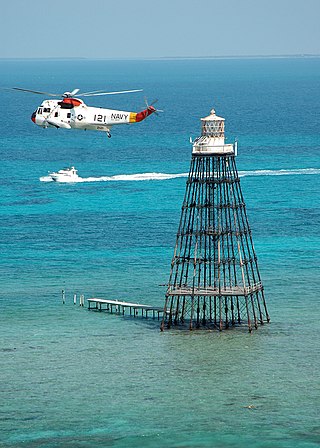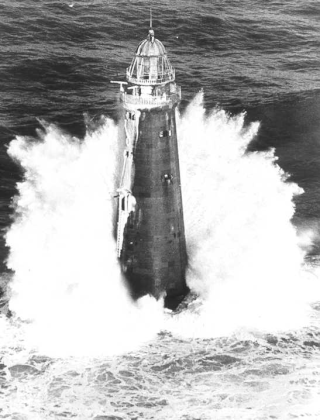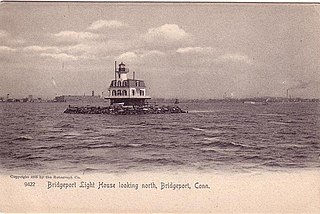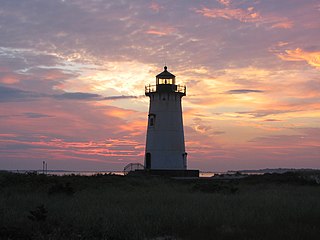
CSS Albemarle was a steam-powered casemate ironclad ram of the Confederate Navy, named for an estuary in North Carolina which was named for General George Monck, the first Duke of Albemarle and one of the original Carolina Lords Proprietor.

St. Clement's Island State Park is a publicly owned historic preservation and recreational area that encompasses St. Clement's Island, an uninhabited Potomac River island lying one-half mile southeast of Colton's Point, St. Mary's County, Maryland. The state park features a 40-foot stone cross dedicated to the beginnings of freedom of religion in the United States as well as a reconstruction of the historic Blakistone Island Light. It is the central feature of the St. Clement's Island Historic District that was listed on the National Register of Historic Places in 1972.

Sand Key Light is a lighthouse 6 nautical miles southwest of Key West, Florida, between Sand Key Channel and Rock Key Channel, two of the channels into Key West, on a reef intermittently covered by sand. At times the key has been substantial enough to have trees, and in 1900 nine to twelve thousand terns nested on the island. At other times the island has been washed away completely.

Several lighthouses called Dog Island Light were constructed on the western tip of Dog Island south of Carrabelle, Florida. They marked the "middle entrance to St. George's Sound," between St. George and Dog Islands, during the nineteenth century, until its collapse by a hurricane in 1873.

The current Egmont Key Light dates from 1858. It is the oldest structure in the Tampa Bay area still used for its original purpose.

Minot's Ledge Light, officially Minots Ledge Light, is a lighthouse on Minots Ledge, one mile offshore of the towns of Cohasset and Scituate, Massachusetts, to the southeast of Boston Harbor. It is a part of the Town of Cohassett, in Plymouth County. The current lighthouse is the second on the site, the first having been washed away in a storm after only a few months of use.
John Donahoo (1786–1858) was a lighthouse builder active in Maryland for much of the first half of the nineteenth century.

The Holland Island Bar Light was a screw-pile lighthouse in the Chesapeake Bay which existed from 1889 to 1960. It is remembered for the unexplained death of one of its keepers, and for being "attacked" by United States Navy pilots during a training exercise.

Alcatraz Island Lighthouse is a lighthouse—the first one built on the U.S. West Coast—located on Alcatraz Island in California's San Francisco Bay. It is located at the southern end of the island near the entrance to the prison. The first light house on the island was completed in 1854, and served the bay during its time as a Citadel and military prison. It was replaced by a taller concrete tower built in 1909 to the south of the original one which was demolished after it was damaged due to earthquake in 1906. The automation of the lighthouse with a modern beacon took place in 1963, the year Alcatraz closed as the Alcatraz Federal Penitentiary. It is the oldest light station on the island with a modern beacon and is part of the museum on the island. Although when viewed from afar it easily looks the tallest structure on Alcatraz, it is actually shorter than the Alcatraz Water Tower, but as it lies on higher ground it looks much taller.

The Bridgeport Harbor Light, later the Bridgeport Harbor Lighthouse, was a lighthouse in Bridgeport, Connecticut, United States. It is located on the west side of the Bridgeport Harbor entrance and the north side of Long Island Sound. Originally constructed in 1851 and rebuilt in 1871 with a dwelling, it had a red-fixed light throughout its service life. The builder and first keeper of the light was Abraham A. McNeil who is also credited as improvising the first light for the Bridgeport Harbor in 1844. By 1953, the lighthouse was in poor condition and the United States Coast Guard opted to build a skeleton tower in its place. In the 2014 edition of the Light List Volume 1, the skeleton tower is marked as "Light 13A" with a height of 57 feet (17 m) and a visual marker of a square green dayboard with a green reflective border. The lighthouse was sold and an attempt was made to move it to serve as a monument for Connecticut's maritime history, but it was later decided to scrap the structure. The lighthouse caught fire and was destroyed during the dismantling in 1953.

Falkner Island Light, also known as the Faulkner Island Lighthouse, is a lighthouse in Connecticut, United States, on Falkner Island which is off Guilford Harbor on Long Island Sound. The lighthouse was constructed in 1802 and commissioned by President Thomas Jefferson. The lighthouse has had three keeper's houses: the original house of 1802 was rebuilt in 1851 and then again in 1871. The 1871 keeper's house survived to 1976, when it was destroyed by fire; the Coast Guard repaired and automated the lighthouse two years later. A volunteer group, the Faulkner's Light Brigade, has undertaken the restoration and preservation of the lighthouse since 1991, completing the last major restoration work in March 2011. Access to Falkner Island and the light is restricted during the nesting season of the roseate terns from May to August yearly. The Falkner Island Lighthouse, as the second oldest extant lighthouse in Connecticut, is listed on the National Register of Historic Places.

Hooper Strait Light is one of four surviving Chesapeake Bay screw-pile lighthouses in the U.S. state of Maryland. Originally located in Hooper Strait, between Hooper and Bloodsworth Islands in Dorchester County and at the entrance to Tangier Sound, it is now an exhibit at the Chesapeake Bay Maritime Museum in St. Michaels, Maryland.

Sambro Island Lighthouse is a landfall lighthouse located at the entrance to Halifax Harbour, Nova Scotia, on an island near the community of Sambro in the Halifax Regional Municipality. It is the oldest surviving lighthouse in North America and its construction is a National Historic Event.

Edgartown Harbor Light is a lighthouse located in Edgartown, Massachusetts, United States, where it marks the entrance to Edgartown Harbor and Katama Bay. It is one of five lighthouses on the island of Martha's Vineyard. The first lighthouse, a two-story wooden structure that also served as the keeper's house, was constructed in 1828. It was demolished, and replaced by the current cast-iron tower, in 1939. Originally located on an artificial island 1/4 miles from shore, the lighthouse is now surrounded by a beach formed, since 1939, by sand accumulating around the stone causeway connecting it to the mainland.

Ship Island Light was a lighthouse in Mississippi near Gulfport.

The Cuckolds Light, known as the Cuckolds Island Fog Signal and Light Station or just Cuckolds Light Station, is a lighthouse located on the eastern pair of islets known as the "Cuckolds" in Lincoln County, Maine. The islets are southeast and in sight of Cape Island, that is just off the southern tip of Cape Newagen on Southport Island, south of Booth Bay, that leads to Boothbay Harbor, Maine.

The Green Island Light is a lighthouse located on Green Island in Lake Erie, U.S. state of Ohio, to the west of the Bass Islands. Abandoned since its deactivation in 1939, it survives as a hollow shell near the existing skeleton tower.

The Green Island Light is a lighthouse located on Green Island in Green Bay. Abandoned since its deactivation in 1956, it survives as a hollow shell near the existing skeleton tower.

The Matagorda Island Light is located on Matagorda Island in Calhoun County, in the U.S. state of Texas. Once under the jurisdiction of the United States Coast Guard, the lighthouse is now managed by the Texas Parks and Wildlife Department.

The Isles of Shoals Light, also known as "White Island Light", on White Island, in the Isles of Shoals, New Hampshire, was first built in 1821. The present structure was built in 1865. The lighthouse and the island are protected by the state as White Island State Historic Site.





















